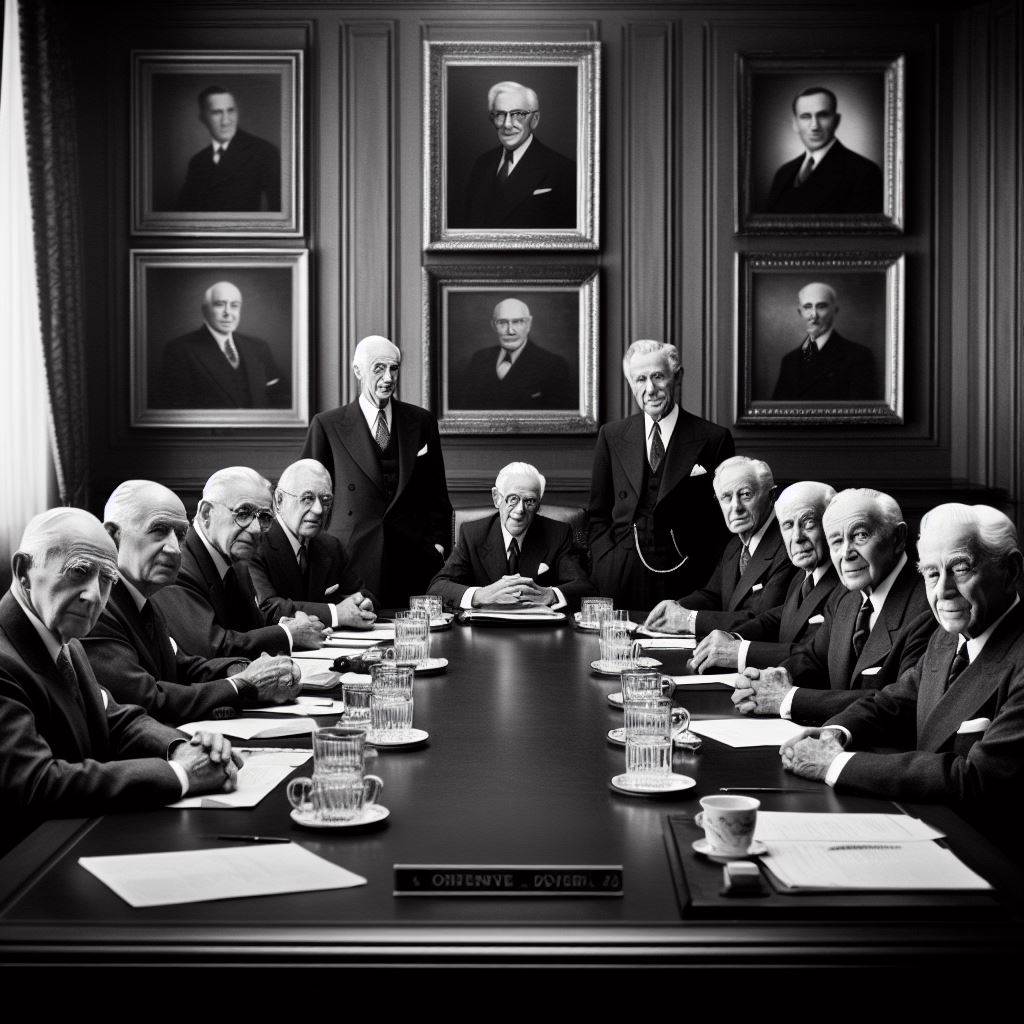
Looking back at how firms used to operate (photo taken at a City firm in 2019).
Freshfields has impressed onlookers after recording a median gender pay gap of 0% for non-partners.
Pay gap reports show the difference in the average pay between two groups (eg men and women) regardless of their job role or seniority. It is therefore different to equal pay reporting which deals with pay differences between men and women who carry out equal work.
The Magic Circle firm confirmed in its recently published report that it achieved a median* pay gap of 0% for UK employees in 2022, dropping from 1% in 2021.
Freshfields' zero stands in stark contrast to other Magic Circle firms, which recorded median gender pay gaps of 41.7% at Slaughter and May, 39.2% at Linklaters, 31.8% at Clifford Chance, and 29.5% at Allen & Overy.
One source remarked that "Freshfields has apparently got rid of its gender pay gap completely", and wondered how the firm had achieved such a landmark ahead of the the rest of the MC. RollOnFriday asked the firm for its magic formula, but it declined to elaborate.
Freshfields' mean gender pay gap for employees increased to 7.6% in 2022 compared to 0.7% in 2021. The firm said the mean increase was the result of a number of factors, including more women in junior support roles and a lower number of women in the top quartile.
When partners were thrown into the mix, Freshfields’ mean overall gender pay gap for 2022 increased to 53.2% (up from 52.1% in 2021) and the median overall gender pay gap increased to 14.8% (up from 12.5% in 2021).
Freshfields also reported on socio-economic background for the first time, analysing the pay gap between three groups of parental background: ‘professional’ (such as teacher, solicitor, accountant), ‘intermediate’ (such as secretary, clerical worker, nursery nurse), and ‘lower socio-economic’ (such as plumber, gardener, postal worker).
The pay gap favoured staff whose parents had professional backgrounds compared to intermediate and lower socio-economic backgrounds, with a median pay gap of 45% in favour of professional backgrounds compared to lower socio-economic, and a mean of 31.3%.
The overall ethnicity pay gap (including partners) increased compared to 2021, with a mean pay gap of 55.9% (up from 50.5% in 2021), and a median pay gap of 10.8% (up from 7.3% in 2021). The firm said it had been "driven by the proportionately relatively small number of partners self-identifying as being from an ethnic minority and higher representation in more junior roles". The firm reported on all ethnic groups collectively, but said it recognised "the limitations of reporting on multiple ethnic groups together".
London Managing Partner Claire Wills said, “I’m particularly pleased that this year we are including pay gap figures on socio-economic backgrounds, which is a key priority for the firm in our global strategy. Our UK colleagues have shown great engagement, and we have worked in partnership with clients and the broader community on multiple efforts, which we believe will help us eliminate pay gaps over the longer term.”
Casting an eye over recent reports from the rest of the Magic Circle - at Slaughter and May the mean gender pay gap for 2022, excluding partners, was 13.8%, while the pay gap for employees and partners combined was 68.5% (mean) and 48.4% (median).
Clifford Chance's mean gender pay gap, excluding partners, was 16.6%. CC's pay gap for employees and partners combined was 63.5% (mean) and 35.1% (median).
Linklaters announced a mean gender pay gap for its employees of 22.4%, while its pay gap for employees and partners combined was 60.1% (mean) and 39.5% (median).
Allen & Overy recorded a mean gender pay gap for its employees of 15.4%, while its pay gap for employees and partners combined was 55.7% (mean), and 39.6% (median).
*Flick through your old GCSE / O-level Maths books if you've forgotten the difference between median and mean.
![]() Let top firms and companies ping your app when they like you for a role. Whether or not you're looking to move, download LawyerUp on the App Store and Google Play.
Let top firms and companies ping your app when they like you for a role. Whether or not you're looking to move, download LawyerUp on the App Store and Google Play.













Comments
111
7
I trust their secret sauce isn't creative accounting...
24
18
Could it be due to a high proportion of female lawyers in well-paid junior (particularly nq) roles, and outsourcing/termination of high-female-proportion business support roles (eg pooling PAs?)
But if that's the case I'd expect a similar figure for Links, A&O, CC at least, as I can't see why they wouldn't have followed a similar strategy and therefore be in a similar position.
25
14
"two groups (eg men and women)"
What about the other 71 genders?
23
20
re other genders.
Funny you should raise that.
There's a note in Freshfields' gender pay gap report:
"Gender is referenced in binary terms of men and women throughout this report, Freshfields recognises that people are non-binary or gender non-conforming too and will not be represented by this breakdown."
20
17
They are clearly doing something creative here. Note it is the median gender pay gap - so that could be dealt with by outsourcing lower paying, stereotypically female dominated functions (PA, etc.) and it doesn't really speak to the split - I am sure some of the people above the median will be earning a hell of a lot more whereas those below, not so much.
What also makes me think there is something suspect here is that I don't think a zero gender pay gap is realistic or actually should be expected. There will always be some differences assuming that there is any element of merit/hours based pay. Interestingly my firm reports at an internal level on gender pay gaps in various PQE bands - these are naturally smaller cohorts but most sit with a pay gap around plus or minus 5% (with it not always the men getting paid more). The explanation is usually that this is driven by bonuses (whether for referring new joiners or bonuses
21
18
Creativity includes giving males derisory pay rises whilst females are given healthy rises. One outcome may be the 33% attrition rate in BS in the last year.
22
19
"Pay gap reports show the difference in the average pay between two groups (eg men and women) regardless of their job role or seniority. It is therefore different to equal pay reporting which deals with pay differences between men and women who carry out equal work"
... it is therefore entirely pointless given that it compares two arbitrarily selected pools of labourers and compares their pay against one another irrespective of whether they do the same jobs or entirely different ones.
But we like doing it because:
1. It's more emotive than reporting that 30% of Job A workers on high pay (say, Computer Scientists) at a company are Female, whereas that's 70% for Job B workers on lower wages (say, HR people) at the same place. Much snappier to say that there's a gender paygap as if the women in HR are somehow being underpaid for their skills. Whatever they are.
2. It's totally, almost wilfully, blind to the fact that entrants to professional occupations - still on lower pay than senior colleagues from previous generations - are becoming overwhelmingly female, in a way that doesn't seem to concern people who usually fuss over representation and equality (sorry, 'equity'). So you don't have to worry that, say, 70% of new lawyers are female. You just publish a stat which reveals, shockingly, that they get paid less than a more male-slanted cohort of people who have been doing the job for a decade as if that's an injustice. Headline sorted. No need to worry about whether that 70% indicates a major equality of opportunity issue.
23
18
How exactly is plumber lower socio-economic and nursery nurse is intermediate? Pretty sure the former earn at least £15-20k more per annum than the latter.
25
14
Great spin on giving everyone a real terms pay cut.
30
16
This reminds me of a middle of the road kid at school who got hold of the answers before an exam and - surprise, surprise - aced it with 100%. His suddenly stellar results were rumbled and he learned a lesson Freshfields needs to as well - make your act convincing.
I’d love to think it is true that my firm is an exemplar, but there’s a strong sense here that the firm’s simply upped its PR game after a bad run (remember Edward ‘the Blacks’ Braham anyone?). The snakelike head of my team is no stranger to not so subtle ‘encouragement’ to up our employee survey ratings. Until proven otherwise, these unbelievable figures remain unbelievable.
Until the culture here matches the PR, I’m taking everything management can influence- including the RoF survey - with a large bag of salt.
22
15
poor replica